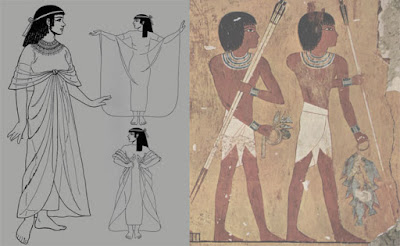Ladies' dress
The Eighteenth Dynasty, which traverses the era from 1550
until 1292 BC, is presumably the most acclaimed of the considerable number of
administrations of antiquated Egypt. This is the age of the tenet of
Tutankhamen, and additionally of Amenhotep IV and his significant other
Nefertiti. This is likewise the Dynasty of Hatshepsut, considered a standout
amongst the best pharaohs and the longest ruling lady of an indigenous Egyptian
tradition.
Until the Eighteenth Dynasty, the ladies wore kalasiris, or
sheath dress, produced using a container of material sewn along one side. The
conventional kalasiris was basic fit as a fiddle. It tumbled from beneath the
bosoms to over the lower legs and was held by two shoulder straps. This could
shift be that as it may. Archeologists have discovered kalasiris bolstered by
sleeves rather than straps, or only one strap rather than two. It could
likewise reach out over the bosom or up to the neck. Despite the fact that
compositions and figures depict such ensembles as formed firmly over the body,
these portrayals are beguiling. Surviving attire is free and streaming for
simplicity of development.
Ladies additionally wore a group of two separate pieces. It
comprised of a wide skirt with flat creases and a short, tight bodice with thin
fitting sleeves. It opened back and front and must be secured with slim ropes.
In the Eighteenth Dynasty new dress styles showed up.
Portrayals of Nefertiti demonstrate her in a long, streaming, creased material
drapery or wearing a long, tight dress under a creased tunic with wide sleeves
that came down to the elbow. A belt secured underneath her bosoms shapes an
Empire line, while a beaded neckline hung at her neck area.
There was amazingly little change in ladies' attire after
the Eighteenth Dynasty, notwithstanding amid the Greek Ptolemaic Dynasty
(304-30 BC). As set up by the principal pharaohs, the elite utilization of hung
cloth articles of clothing and the wearing of comparative styles by men and
ladies remained practically unaltered as the primary elements of antiquated
Egyptian outfit.
Men's dress
The customary male piece of clothing was the white material
kilt or schenti, a rectangular fabric wrapped around the lower body and tied in
front. Underneath it, men wore a triangular loincloth in some cases affixed
with rope ties. The length, totality and technique for conformity of the kilt
changed with the wearer's social position and the noteworthy age.
The first schenti was made of cowhide or shroud, which was
later supplanted by a light fabric, generally cloth.
Later kilts were more precise and intensely pressed. The
solid material would stand out and make a triangle, which stressed the genital
range. This zone was viewed as holy for its reproduction part.
Men's outfit advanced step by step. One of the primary
developments to take after the schenti was the loin skirt. In the Middle of
Kingdom men wore long material skirts over the kilt. They changed long and were
some of the time held set up by an improving belt.
Egypt's victory of Syria in the fifteenth century BC
presented the tunic and the robe. The Syrian weavers imported advanced weaving
systems that prompted better material generation. The tunic, a small sleeved
nightshirt, was worn over the schenti, while the robe was entangled in
structure and was produced using of fabric twice the length of the wearer's
tallness. It had a wide neck area, wide sleeves and the skirt was accumulated
at the waist. The robe is likely the strangest Egyptian piece of clothing.





0 comments:
Post a Comment